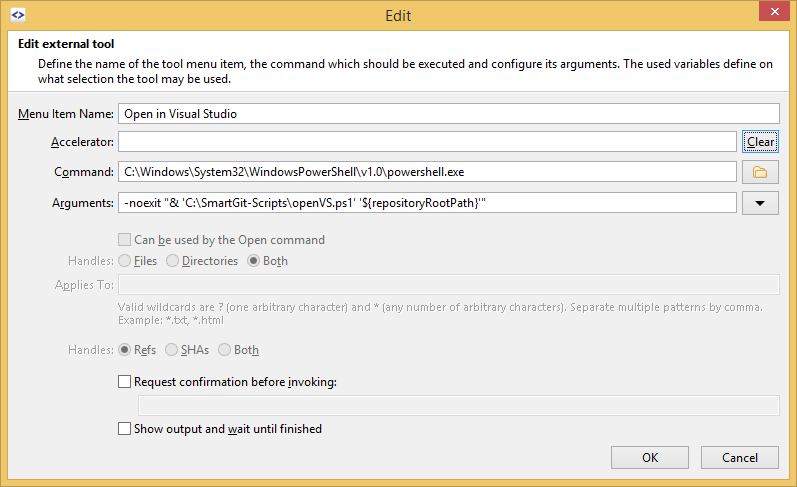Tools
On the Tools preferences page you can define external tools which can operate on certain selections.
The configuration is stored in tools.yml file in the settings directory, but it might be easier to use the Export and Import buttons to share your configuration with team members.
Default Tools
By default, some default tools will be configured on the first application start.
The Open File tool will invoke the system’s default open command, e.g. to launch a graphic viewer for .png files.
The Open in Terminal tool will open the selected directory in the terminal application.
The Open Git-Shell tool will open the repository in the Git shell.
To re-add default tools, click the Re-Add Defaults button.
Note
With SmartGit 22.1 the default tools have been cleaned up. The Git version is now displayed in the preferences, Fast-forward Merge has been implemented as SmartGit command.
If you are missing further tools from SmartGit version before 22.1 (e.g. Set Executable Flag, Format Patch, Apply Patch, Verify Database or Git Config), please download this file for Windows or Linux/MacOS and Import that in SmartGit.
Configure a Tool
Use Add or Copy to create a new tool (using the latter will copy all values from the currently selected tool for easier application of tiny changes).
The Command means just the executable file without any argument. The Arguments can contain following variables accessible using the drop-down button at the right:
${filePath}= the path of the selected file or directory, e.g.C:\repository\readme.txt${fileName}= the name of the selected file or directory, e.g.readme.txt${fileUri}= the URI of the selected file or directory, e.g.file://C:/repository/readme.txt${repositoryRootPath}= the root path of the repository, e.g.C:\repository${selectionFile}= the path of a temporary file containing all selected file paths, one file per line, e.g.C:\temp\selected-91235${remoteUrl}= the remote (push) URL of the repository, e.g.https://github.com/user/project.git${encoding}= the configured text file encoding, e.g.UTF-8${commit}= the (single or first) selected commit or ref (depending on the Handles: Refs, Commits, Both option), e.g.feature/new-layout${commit2}= the second selected commit or ref, e.g.feature/old-layout${fileOpen}= the path of a existing file that the user will have to select when invoking the tool, e.g.D:\download\my-patch.txt${fileSave}= the path of a file that the user will have to select when invoking the tool; if existing, the user needs to confirm the overwrite${dirSelect}= the path of a directory that the user will have to select when invoking the tool, e.g.D:\export${git}= the path of the configured Git executable, e.g.C:\Program Files\SmartGit\git\bin\git.exe${gitDir}= the (root) path configured Git installation, e.g.C:\Program Files\SmartGit\git${smartGitDir}= the (root) path of the SmartGit installation, e.g.C:\Program Files\SmartGit
The working directory when launching the tool will be the root directory of the corresponding repository (which may also be a submodule). When launching a tool on a set of files which belong to different repositories, it will be the closest common directory of all affected repositories.
If Can be used by the Open command is selected, SmartGit will consider to use this tool when invoking Open (or Open from Working Tree) in the Files view. The Handles: Files, Directories, Both and Handles: Refs, Commits, Both options determines on what selection the tool should operate, e.g. on file, directory, ref (tags or branches) or commit selection.
A file or directory name pattern may be specified in Applies To.
Note
For repository root directories, the name “” (empty string) is used as name which only is matched by the pattern “*”.
If Request confirmation before invoking is selected and a message is provided, the user needs to confirm this dialog’s message before the command is invoked. If Show output and wait until finished is selected, SmartGit waits until the command is finished and shows the output.
Example Tools
Format Patch
Save this content to a file format-patch.yml and use the Import button on the Tools page of the preferences to restore the Format Patch feature from SmartGit versions < 22.1.
tools:
- name: Format Patch
fileStarter: {command: '${git}', parameters: 'format-patch -o "${dirSelect}" -1 ${commit}'}
useForOpen: false
waitUntilFinished: true
filePattern: '*'
- name: Format Patch
fileStarter: {command: '${git}', parameters: 'format-patch -o "${dirSelect}" ${commit}..${commit2}'}
useForOpen: false
waitUntilFinished: true
filePattern: '*'
Apply Authorship
The following tool can be used to apply the authorship information (name, email, and dates) of the selected commit (in the Log graph) to the current HEAD commit.
Note
The following definition apply for Windows. For Linux/macOS you will have to adjust the escaping/quoting.
Save this content to a file apply-authorship.yml and use the Import button on the Tools page of the preferences.
tools:
- name: Apply Authorship
fileStarter: {command: '${gitDir}\bin\bash.exe', parameters: '-c "COMMIT_HASH=$1;
AUTHOR_INFO=$(git show -s --format=''%an <%ae>'' $COMMIT_HASH); AUTHOR_DATE=$(git
show -s --format=''%ad'' --date=iso-strict $COMMIT_HASH); COMMIT_DATE=$(git
show -s --format=''%cd'' --date=iso-strict $COMMIT_HASH); [ -z ''$AUTHOR_INFO''
] && echo ''Failed to extract author information from commit $COMMIT_HASH''
&& exit 1; GIT_COMMITTER_DATE=""$COMMIT_DATE"" git commit --amend --author=\""$AUTHOR_INFO\""
--date=""$AUTHOR_DATE"" --no-edit" -- ${commit}'}
useForOpen: false
waitUntilFinished: true
filePattern: '*'
forRefsNotShas: false
requiresConfirmation: true
confirmationMessage: Do you want to apply the authorship information from the selected
commit?
Open top-most Visual Studio solution from current repository
This powershell script can be used to open a solution file .sln inside a repository, in Visual Studio.
The script iterates through the repository folders and looks for a .sln file.
It stops at the first match and then launches Visual Studio.

Powershell script C:\SmartGit-Scripts\openVS.ps1
Install-Module VSSetup -Scope CurrentUser
$slnname = Get-ChildItem -Path $args[0] -Filter *.sln -Recurse -ErrorAction SilentlyContinue -Force | Select-Object -First 1 | Select-Object -ExpandProperty FullName
switch ( $args[1] )
{
2017
{
$ver = '[15.0,16.0)'
}
2019
{
$ver = '[16.0,17.0)'
}
default
{
$ver = '[1.0,1000.0)'
}
}
$devenv = Get-VSSetupInstance | Select-VSSetupInstance -Version $ver -Latest | Select-Object -ExpandProperty InstallationPath
$devenv = $devenv + "\Common7\IDE\devenv.exe"
Start-Process -FilePath $devenv -ArgumentList $slnname
